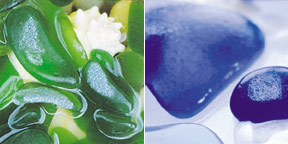|
Between the Covers
 Pure Sea Glass: Discovering Nature’s Vanishing Gems Pure Sea Glass: Discovering Nature’s Vanishing Gems
by Richard LaMotte; photos by Celia Pearson
LaMotte and Pearson set the standard by which sea glass evidence can be read.
Reviewed by Sonia Linebaugh
Pure Sea Glass begins “There is a splendid irony in collecting sea glass, since this alluring trophy sought after in the shifting sand was once merely sand itself.”
With this sentence, author Richard LaMotte of Chestertown sets the stage for a story not so much about the attraction of those pleasant bits of colored glass beloved by beach walkers as about the backstory of the shards. Here you’ll learn the what, how and why of those glittering colors.
But first, the beauty of glass delights the reader in 150 photographs by Annapolitan Celia Pearson. Shot in natural daylight in Pearson’s studio/living room, the glass is a visual treat in color sets of rare red and orange, pinks and opaque whites, uncommon ambers and soft blues, through common Kelly greens and clear whites, for 24 colors in all.
Through the photographer’s lens, sea glass looks like sugared gummy candy, good enough to eat.
It’s enough to send the reader searching through jars and boxes of shells, shark’s teeth and surely a few bits of colored glass brought home from the shores of the Chesapeake or other exotic places.
If looking is not enough, LaMotte’s explanation of how natural weathering changes broken bottles, vases and car windows into sea glass provides lesson after lesson in human and natural chemistry.
Glass is made with ingredients that have remained constant for over 4,000 years. Potassium or soda-lime in the formula results in different colors. Other effects are produced by iron oxide in sand and by firing temperatures. You’ll learn to tell the difference between a Coca-Cola bottle and a mason jar and understand the impact of the Industrial Revolution on glass.
Pearson and others provide photographs of such original objects: barber bottles and beer bottles popular before 1920, cobalt blue Milk of Magnesia bottles, bottles for drugs, ink, gin, poison, whiskey and soda. Photos introduce you to flashed glass, hobnail glass, opalescent, satin and more.
Between Pearson’s photos and LaMotte’s explanations, here is enough information to turn an ordinary beach comber into a sea-glass investigator.
Though others established standards for glass-bottle collectors, LaMotte is the one setting the standard by which sea glass evidence can be read. His expertise on color matching and chemistry come from his background in water-purity testing at a company his grandfather founded in 1919.
LaMotte’s interest in applying his expertise to the history and chemistry of sea glass was sparked by his wife, jeweler Nancy LaMotte.
The two amassed 3,000 pieces of sea glass, looking for the finest to use in Nancy’s jewelry creations. At craft shows, Nancy sold jewelry, while Richard talked to people over pieces of sea glass.
“People kept asking the same questions,” says LaMotte. “Where did it come from? How did it get there? I couldn’t answer them, so I had to find out.
“When Nancy and I met Celia and saw her photographs of seashells, I decided that all the bits and pieces of information I had put together had to go into a book.”
For Pearson, the meeting was fateful. In addition to her work photographing architectural exteriors and interiors, she had been photographing intimate beach scenes for years.
“It was wonderful to play with glass until I found the right background for each shot,” she said. “The glass is truly gem-like. I’m thrilled with the results.”
Readers are thrilled too, based on the passionate reception LaMotte and Pearson received at a recent book signing at MFA Gallery in Annapolis. Beach combers and sea glass collectors besieged the two with stories and questions and gratitude. It seems there is something about sea glass that delights and intrigues those who walk the edge of the sea.
Order the book at www.pureseaglass.com or look for it in Annapolis at MFA Gallery, Aurora Gallery and the Historic Annapolis Museum Store. See more of Pearson’s work at www.pearsonphotography.com.
|


 Pure Sea Glass: Discovering Nature’s Vanishing Gems
Pure Sea Glass: Discovering Nature’s Vanishing Gems